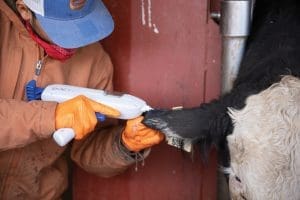
By Patti Wilson Contributing Editor
Proper administration is the foundation of capturing return on investment with growth implants. Making the administration easier is the goal with the new applicator from Zoetis.
I spoke with Paul Parker, senior marketing manager feedlot-stocker segment at Zoetis. He described the new Synovex implant applicator and the reactions that cattle producers are sharing about the improved gun since its introduction in February. There’s nothing like the real world to determine handiness and function.
The all-new Exact 10 applicator is compatible with all Synovex implants. With several months of use at this time, it has been favorably received in feedyards and stocker operations. The new applicator was designed to make implant administration easier to do correctly every time, avoiding crushed, broken or lost pellets. A spring-loaded needle automatically retracts upon placement of the implant. There is no need to pull it back while dispensing, which helps to get the job done right every time.
A special rear-cocking mechanism makes it ambidextrous, so it’s equally handy for left- or right-handed users. Exact 10 automatically advances to the next dose after the initial implant, and a last-dose alert tells you when to install a new 10-dose cartridge.
Parker emphasizes how critical it is for cattle operations to have well-trained employees or crews administering animal health products, especially growth implants. A single implant can add more than 90 pounds of weight to a feedlot steer; just think about that lost revenue if the implant is missing due to improper administration or infection.
Zoetis offers chuteside instruction to aid success of any product in employee administration. Instruction tools including videos are available, as well as follow-up assessment forms. When requested, Zoetis personnel are ready and willing to teach, refresh and evaluate working crews.
Parker notes that employee turnover can be high, making regularly scheduled schooling sessions imperative. Common sense tells us that quality of labor does vary over time. Consequently, proper implanting can fluctuate from lot to lot. A 95 percent success rate on implants is an achievable goal. Less than 80 percent (or 20 percent failed implantation) is poor.
Zoetis recommends administering implants into a clean, dry ear to help reduce infection; a brush dipped in chlorhexidine solution works best on dirty or wet ears and ensures good results. Small improvements make a big difference.
Parker says correctly placed and cleanly applied implants can add $100 per head improvement in cattle performance. In the bigger picture, implants have an annual impact on the U.S. beef industry of $2 billion in performance and efficiency.







